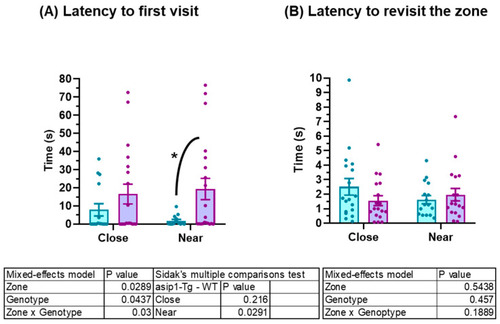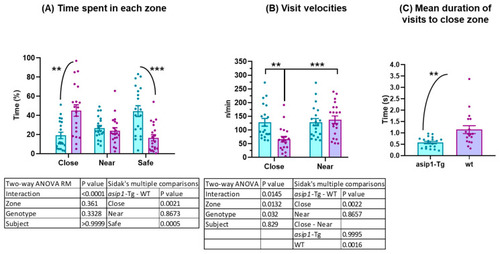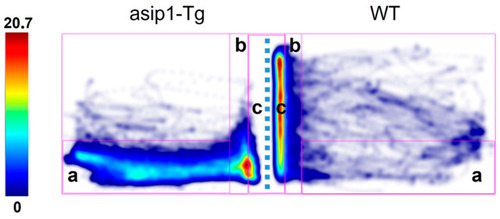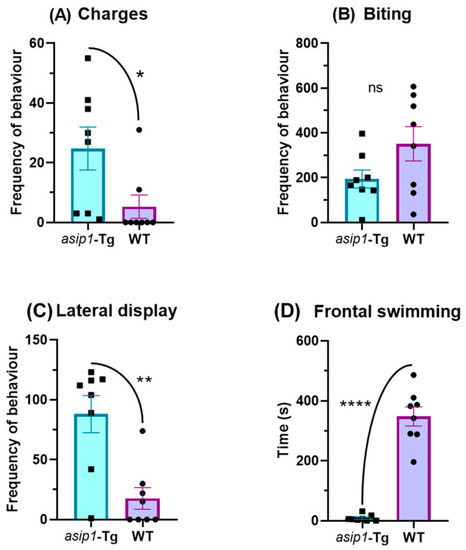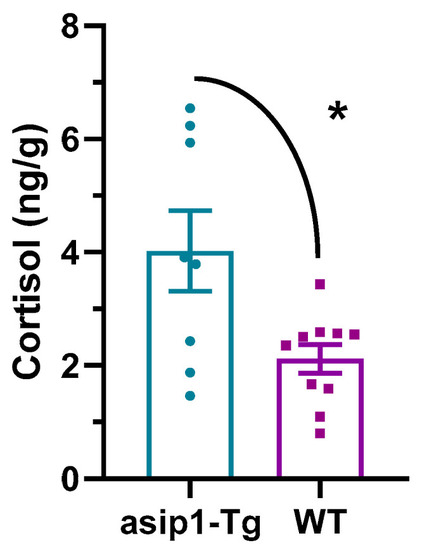- Title
-
Agouti-Signalling Protein Overexpression Reduces Aggressiveness in Zebrafish
- Authors
- Rocha, A., Godino-Gimeno, A., Rotllant, J., Cerdá-Reverter, J.M.
- Source
- Full text @ Biology (Basel)
|
Behavioural differences between transgenic (asip1-Tg) and wild-type (WT) zebrafish in dyadic fights. (A) Latency to the first bite, (B) Number of animals biting first, (C) frequency of behavioural profiles, and (D) number of dominant fish. Experiments were performed on 20 WT and 20 asip1-Tg fish paired by age and size. Data are represented as mean ± SEM and analysed by unpaired t-test (latency to first territory intrusion) or as the number of fish and analysed by Chi-square test (dominant fish) or Fisher’s exact test (first to bite). Asterisks indicate statistical differences between genotypes (*** p ≤ 0.001, **** p ≤ 0.0001). |
|
Behavioural differences between asip1-Tg and WT in the mirror–image stimulus test. (A) Latency to both first approximation (close area) and exploration (near area); (B) Latency to repeat approximation and exploration behaviours. Experiments were performed on 20 WT and 20 asip1-Tg fish. Data are represented as mean ± SEM and analysed by two-way ANOVA repeated measures (RM), followed by Sidak’s multiple comparison test. Blue and purple colours represent asip1-Tg and WT fish, respectively. Asterisks indicate statistical differences between genotypes (p ≤ 0.05). |
|
Behavioural differences between asip1-Tg and WT in the mirror–image stimulus test. (A) Time spent in three previously defined areas: (i) a safe area consisting of the bottom part of the tank; (ii) an area near the mirror; and (iii) an area close to the mirror where direct contact of the fish with the mirror may take place. (B) Visits’ velocity is computed as the number of entries per minute spent near or close to the mirror. (C) Mean duration of visits to the close area. Experiments were performed on 20 WT and 20 asip1-Tg fish. Data are represented as mean ± SEM and analysed by two-way ANOVA repeated measures (RM) followed by Sidak’s multiple comparison tests for (A,B) or unpaired t-test for (C). Asterisks indicate statistical differences between genotypes (** p ≤ 0.01, *** p ≤ 0.001). Blue and purple colours represent asip1-Tg and WT fish, respectively. |
|
Representative heatmaps of asip1-Tg (left) and WT (right). The colour scale represents the cumulative time spent in each of the previously defined arena zones. (a) a safe area consisting of the bottom part of the tank; (b) near the mirror zone, an exploration area where fish can approach but not touch the mirror; and (c) a close to the mirror area where direct contact of the fish with the mirror can take place. The dotted line represents the position of the mirror. |
|
Frequency and duration of aggressive-related behaviours of asip1-Tg and WT in the mirror-stimulus test. (A) Charges; (B) biting; (C) lateral display; (D) frontal swimming. Data relate to 8 WT and 8 |
|
Whole-body basal cortisol levels in asip1-Tg and WT zebrafish. Ten fish of each genotype were homogenised, and cortisol was extracted and quantified by EIA. An asterisk indicates statistical differences between genotypes (* p terisk i). |


